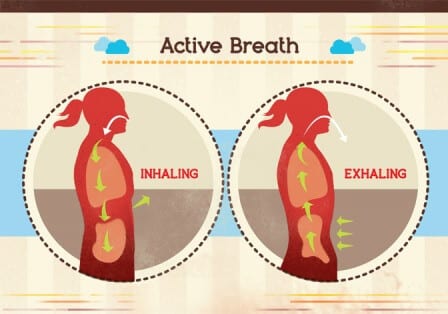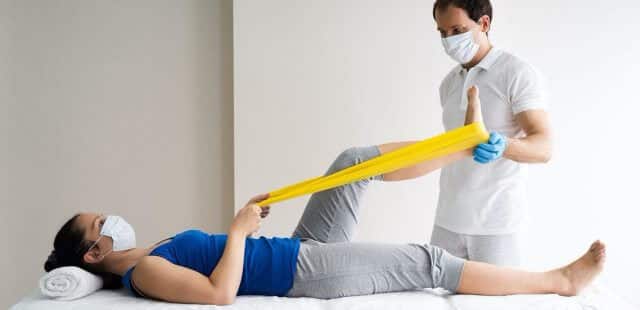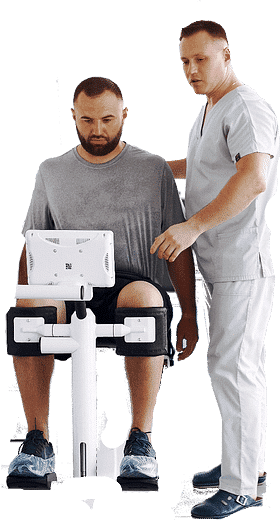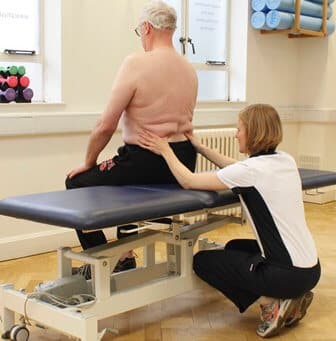physiotherapy in Post Covid-19 rehabilitation
Call Us: +91-9421750231, +91-7875411115.
What is the role of physiotherapy in Post Covid-19 rehabilitation

physiotherapy in Post Covid-19 rehabilitation. COVID-19 is a new virus that has affected many people across the world, symptoms
include:
- A high temperature- this means you feel hot to touch on your chest or back
- A new, continuous cough- this means coughing a lot for more than an hour, or 3 or more coughing episodes in 24 hours
- Less of taste or smell
At times people require admission into the hospital for intensive care support to help with their breathing, this can cause some patients to experience muscle weakness, shortness of breath and fatigue. After you have been ill, especially for a long time, it is normal to take a while to feel like yourself again. How long this takes can vary from person to person. physiotherapy in Post Covid-19 rehabilitation that people may experience and provide advice on how to deal with them.

Role of physiotherapist in post-covid-19 Rehabilitation
India has witnessed a sudden surge in COVID 19 cases, which is not only affecting older adults but also the younger population. Symptoms such as breathlessness, fatigue and muscle weakness if not managed on time, can lead to a prolonged limitation in functional capacity, exercise tolerance, hamper the quality of life and delay return to work and everyday routine.
As per WHO guidelines, physiotherapy can play an important role in the rehabilitation of patients with COVID-19 to improve these symptoms, “The respiratory system is one of the worst-hit systems of the body, so it makes it imperative to seek specific pulmonary rehabilitation. physiotherapy in Post Covid-19 rehabilitation, For rehabilitation, a multidisciplinary approach consisting of pulmonologist, cardiologist, neurologist, physiotherapist, dietician and psychologist is required,
People with mild symptoms can do simple breathing exercises like controlled breathing exercises, paced breathing, gradually increasing the functional capacity starting with bedside mobility and progressing to daily activities as per their capacity.
Benefits of physiotherapy in Post Covid-19 rehabilitation

Health and functioning
*Rehabilitation can reduce Intensive Care Unit -admission related complications, such as Post Intensive Care Syndrome. The aim of rehabilitation is to improve recovery and reduce disability
-Physical impairments
-Cognitive impairments
-Swallow impairments
-Provision of psychosocial support
Discharge Facilitation
During the pandemic, there is a high demand for hospital beds in countries worldwide, especially during the times when the pandemic reaches its peak in a country or area. This leads to patients being discharged sooner than would normally be the case. Rehabilitation is crucial in this scenario to prepare a patient for discharge, coordinating complex discharges, and also safeguard the continuity of care.
Reducing the risk of readmission
A patient who has severe COVID-19 will go through multiple phases of care – acute, post-acute, and long-term care. In the acute phase, care will most likely be provided in the ICU or critical care units. In the post-acute phase, care will most likely be provided in a hospital ward, or a step-down or rehabilitation facility. The long-term phase will be when patients return home and are still recovering and will receive rehabilitation at the community level.
Common COVID-19 Complications Are
Acute respiratory distress syndrome (ARDS)
Condition in which fluid collects in the air sacs of the lungs, depriving organs of oxygen. Acute respiratory distress syndrome (ARDS) can occur in those who are critically ill or who have significant injuries. It is often fatal, the risk increasing with age and severity of illness. People with ARDS have severe shortness of breath and often are unable to breathe on their own without support from a ventilator. Treatment includes oxygen, fluid management and medication.
sepsis or septic shock
Septic shock is a life-threatening condition caused by a severe localized or system-wide infection that requires immediate medical attention. Symptoms include low blood pressure, pale and cool arms and legs, chills, difficulty breathing and decreased urine output. Mental confusion and disorientation may also develop quickly. Emergency treatment may include supplemental oxygen, intravenous fluids, antibiotics and other medications.
Multi-organ failure
In the present study, multiple organ failure occurred in 47% of the patients and was significantly associated with long-term survival and functional status. Of the 322 patients, 75% were still alive at follow-up 2 to 7 years after discharge from the ICU.
Acute kidney injury
Acute renal failure develops rapidly over a few hours or days. It may be fatal. It’s most common in those who are critically ill and already hospitalized. Symptoms include decreased urinary output, swelling due to fluid retention, nausea, fatigue and shortness of breath. Sometimes symptoms may be subtle or may not appear at all. In addition to addressing the underlying cause, treatments include fluids, medication and dialysis.
Cardiac injury
Blunt cardiac injury is blunt chest trauma that causes contusion of myocardial muscle, rupture of a cardiac chamber, or disruption of a heart valve. Sometimes a blow to the anterior chest wall causes cardiac arrest without any structural lesion

COMMON physiotherapy in Post Covid-19 rehabilitation
Patients recovering from COVID-19 often experience a feeling of tiredness and
exhaustion both physically and mentally caused by gentle exertion, this will improve in time, physiotherapy in Post Covid-19 rehabilitation.
During your illness, you will probably have lost some weight and muscle strength, and your joints may be stiff. It is estimated that you will have lost 2% of your muscle mass each day during your illness. It is difficult to place a timescale on recovery as everyone recovers at a different rate, but you should not be concerned if it takes weeks or even months to get fully back to normal.
The only way to recover and to get stronger is to walk and exercise “little and often”. It is important to pace your activities so you don’t do everything in one go. Decide on the number of activities you need to do that day or even across the week, then make a plan to spread out the activities so you have adequate rest periods, physiotherapy in Post Covid-19 rehabilitation.
physiotherapy in Post Covid-19 rehabilitation TECHNIQUES ARE:
- Breathing control
- Deep breathing exercises
- Huffing
- The small-long huff
- The big-short huff
Physiotherapy exercises For Back Pain

Breathing control
- Breathing control is breathing gently, using as little effort as possible. Breathe in and out gently through your nose if you can.
- If you cannot, breathe through your mouth instead, If you breathe out through your mouth, purse your lips like you are blowing out a candle
- Try to let go of any tension in your body with each breath out
- Gradually try to make the breaths slower
- Try closing your eyes to help you to focus on your breathing and to relax

Deep breathing exercises
Deep breathing is an easy way to relax and let your worries go. You can do it pretty much anywhere, and it only takes a few minutes. Also called belly breathing, diaphragmatic breathing, and abdominal breathing, it helps ease stress. It can also lower your blood pressure and relax tense muscles.
- Take a long, slow, deep breath in, through your nose, if you can. Try to keep your chest and shoulders relaxed.
- Breathe out gently and relaxed, like a sigh. You should do three-five deep breaths.
- Ask your physiotherapist to help you choose the right number of deep breaths for you.

Thoracic Expansion Exercise
Deep breathing/thoracic expansion exercises are deep breathing exercises that focus on inspiration and help to loosen secretions on the lungs. Instructions to patient: Try to keep your chest and shoulders relaxed. Take a long, slow and deep breath in, through your nose if you can.
- Try to keep your chest and shoulders relaxed.
- Take a long, slow and deep breath in, through your nose if you can.
- At the end of the breath in, hold the air in your lungs for 2-3 seconds before breathing out

Diaphragmatic Breathing Exercises
Diaphragmatic breathing is a type of breathing exercise that helps strengthen your diaphragm, an important muscle that helps you breathe as it represents 80% of breathing.
- Lie on your back on a flat surface (or in bed) with your knees bent. You can use a pillow under your head and your knees for support if that’s more comfortable.
- Place one hand on your upper chest and the other on your belly, just below your rib cage.
- Breathe in slowly through your nose, letting the air in deeply, towards your lower belly. The hand on your chest should remain still, while the one on your belly should rise.
- Tighten your abdominal muscles and let them fall inward as you exhale through pursed lips. The hand on your belly should move down to its original position.

Segmental Breathing
Place your hands along the lateral aspect of the lower ribs to fix the patient’s attention to the areas in which movement is to occur. Ask the patient to breathe out, and feel the rib cage move downward and inward. As the patient breathes out, place firm downward pressure into the ribs with the palms of your hands.
- Lateral costal expansion
- Posterior basal expansion
- Right middle lobe or lingula expansion
- Apical expansion
- Glossopharyngeal Breathing
FREQUENTLY ASKED QUESTIONS
how physiotherapy help after covid-19?
Physiotherapists will help patients to the edge of a bed, sit in a chair and stand up from a seated position. Often they use tilting chairs or hoists to support the movement. Simple exercises also force patients to breathe a little harder. This strengthens a patient’s respiratory system, which prepares them for learning to dress, move and make cups of tea again.
How long does it take to recover from covid 19?
In most cases of covid-19 your body will heal itself, and staying active and continuing with your usual activities will normally promote healing. covid-19 will usually last from a few weeks to a few months.
What is the fastest way to cure covid-19?
- Physiotherapy for COVID-19 TECHNIQUES ARE:
Breathing control
Deep breathing exercises
Huffing
The small-long huff
The big-short huff
WHAT MAKES YOU BETTER THAN OTHER PHYSIOTHERAPISTS?
you’ll benefit from a prompt flexible service. That includes a professional assessment and diagnosis followed by a tailor-made rehabilitation program suited to your individual needs. They have extensive experience, working both in clinics and Physiotherapists’ home visits.
What are the common problems durring rehabilitation ?
Rehabilitation can reduce Intensive Care Unit -admission-related complications, such as Post Intensive Care Syndrome. The aim of rehabilitation is to improve recovery and reduce disability
-Physical impairments
-Cognitive impairments
-Swallow impairments
-Provision of psychosocial support
How much does a session of Manual therapy cost?
The average cost of a physiotherapy session is 600 – 700 Rs. This is the average across Pune. The cost of a physiotherapy session can be as low as 500 Rs. as manual therapy is also included in the session you don’t need to pay any extra cost for manual therapy.
How do you know if you need physiotherapy?
If you had a particularly hard day at the gym, you would feel sore afterward. But if your pain is persistent and not getting any better, that is a sure sign that you need to see a physiotherapist. Likewise, mobility and movement are reasonably constant for a person. Sure, with age they change, but not overnight.
WHAT SHOULD I EXPECT ON FIRST VISIT ?
Our Physiotherapists will try to understand what your goals are, they will explain how they will assess you and ask for your consent before they start. After the assessment, the physiotherapist will explain what physiotherapy can help you with, how long it might take, and the expected outcome from the treatment.
